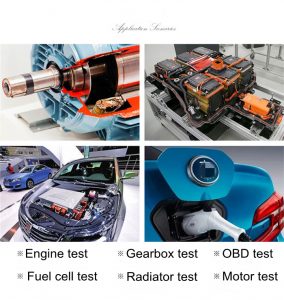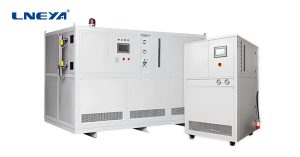Semiconductor probe cooling chiller system
Semiconductor probe chiller, also known as semiconductor testing chiller or semiconductor testing cooling system, is a device designed to provide precise temperature control for semiconductor testing environments.
It plays a crucial role in the testing process of semiconductor chips, especially in wafer level testing, post packaging testing, and fault analysis. The following is an overview of its main features and applications:
Functional features:
- Temperature control: The chiller provides precise temperature control, typically ranging from -40 ° C to over 100 ° C, or even wider, to meet different testing temperature requirements.
2. Stability: The temperature stability of the chiller is extremely high, ensuring minimal fluctuations during the testing process and avoiding temperature fluctuations that may affect the test results.
3. Quick response: The chiller quickly reaches the set temperature and can be adjusted quickly, reducing waiting time and improving testing efficiency.
4. Silence and energy-saving: The probe station chiller is designed to operate with low noise and energy efficiency to reduce energy consumption.
5. Intelligence: Automatic control system for probe chiller, including remote monitoring, alarm, data recording, and fault diagnosis.
Anwendung:
- Chip testing: In semiconductor wafer testing, the probe stage chiller is used to cool the wafer, control the testing environment, and ensure the stability of the equipment and DUT or HTOLBIST (High Temperature Storage Test) during high temperature testing.
2. Packaging testing: In the post packaging testing (FT) stage of semiconductor packaging, the chiller is also used to maintain the testing temperature and ensure the performance of the chip during high-power testing or high-temperature operation.
3. Fault analysis: In semiconductor fault analysis, the chiller helps to simulate specific temperature conditions, analyze the performance of the chip at different temperatures, and identify the cause of the fault.
4. Aging test: In the accelerated aging test of semiconductors, the chiller provides a stable high-temperature environment, accelerates the chip aging process, and quickly verifies its long-term reliability.
5. Environmental simulation: In environmental testing, semiconductors simulate various temperature conditions to ensure that the chip performs in extreme environments and meets design standards.
In summary, the semiconductor probe chiller is an important auxiliary equipment in the semiconductor testing process, ensuring the accuracy and efficiency of testing, especially in temperature sensitive testing environments and reliability verification. It is indispensable.
Verwandte Empfehlungen
-
Purchasing Strategy of Ultra-low Temperature Freezer
926The performance of refrigeration system determines the overall performance. If refrigeration technology is good, excellent refrigeration effect can be achieved quickly. It takes only 4-5 hours on average from room temperature to minus 8 degrees Ce...
Details anzeigen -
Wie lässt sich die Ausfallrate des Wasserkühlungssystems des neuen Energiemotortests verringern?
976Neue Energie Motor Test Wasserkühlung System muss darauf achten, während der Nutzung, egal wie gut Ausrüstung für eine lange Zeit verwendet wird, einige Probleme mehr oder weniger auftreten. Also, wie können wir die Ausfallrate der Ausrüstung während des Gebrauchs zu minimieren?
Details anzeigen -
Use and maintenance of laboratory/bioengineering temperature control system
9311. Read the equipment manual carefully before use, get familiar with the operation process and key instructions, and operate in strict accordance with the conditions specified in the manual. 2. When moving the laboratory/bioengineering temperatur...
Details anzeigen -
Description of power consumption in LNEYA large refrigeration unit
1248In the process of operation, the cooling capacity and working conditions will affect the power consumption of the entire large refrigeration unit, but in order to avoid unnecessary power consumption, we need to understand the other power consumpti...
Details anzeigen
 LNEYA Industriekühler Hersteller Lieferant
LNEYA Industriekühler Hersteller Lieferant












